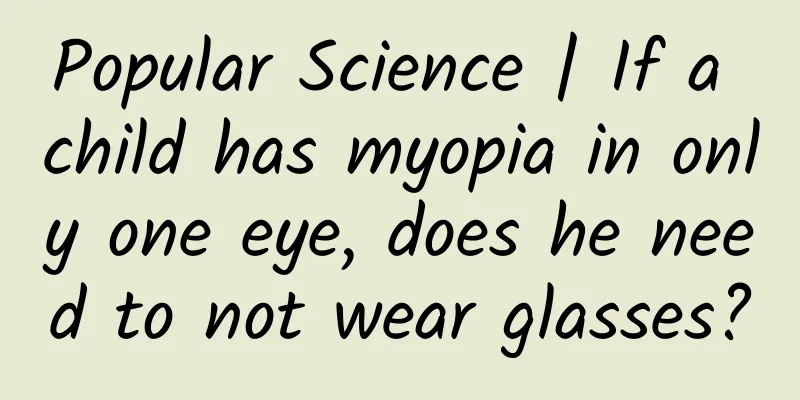Popular Science | If a child has myopia in only one eye, does he need to not wear glasses?

|
"My child has normal vision in one eye and myopia in the other eye, but he says he can see the blackboard clearly. Does he need to wear glasses?" I believe many parents have this doubt. Here, the editor directly announces the answer: NO! You must wear glasses to correct your vision !!! What is anisometropia? Why do the degrees of myopia or astigmatism in the two eyes differ when we see things with both eyes? In fact, during the development of our eyes, there are certain differences in the refractive state of most people's eyes . What's more, one eye may be myopic and the other may not be myopic. In ophthalmology, the phenomenon of "inconsistent refractive state of the two eyes" is called anisometropia . In fact, most myopic people have more or less anisometropia, but most of them have little difference in the degree of binocular vision, no obvious symptoms, and no impact on eye health. It is physiological anisometropia. However, when the difference in the amount of anisometropia is 250 degrees, it is considered pathological anisometropia and must be paid attention to. Usually, our two eyes work together, not separately. Just like walking on two legs, if one leg is longer than the other, you may walk with a limp. A large difference in degree will also make it difficult for the binocular fusion to cause many problems. What effects does anisometropia have on the eyes? 1. More prone to visual fatigue The large difference in the degree of vision between the two eyes can easily lead to consequences such as visual fatigue, dry eyes, tearing, headache, nausea, dizziness, etc., and there may be deviations in judging distances and angles. 2. The poor eye's vision declines faster There is a principle when using eyes - "use it or lose it", that is, the good eye should be used frequently, and the bad eye should be gradually stopped from being used. In this way, the eye with poor vision will experience a phenomenon of myopia increasing rapidly and vision decreasing rapidly. 3. Can cause monocular amblyopia When a child has anisometropia in both eyes, the eye with smaller refractive power can see things more clearly, while the eye with larger refractive power cannot see things clearly, and the brain cannot fuse the two images with different clarity into one. At this time, the brain will command the eye with smaller refractive power to work, and inhibit the eye with larger refractive power from working. Over time, the eye with larger refractive power will develop into amblyopia . 4. Can cause monocular strabismus When the brain cannot fuse two images of different clarity into one, it actively suppresses the visual development of the eye with poorer vision . If one eye is "blind" for a long time, the child may lose stereoscopic vision. If effective treatment is not carried out, the poorer eye may develop strabismus over time. What should I do if I have anisometropia? The most common and simple way to correct anisometropia is to fit glasses . Children have greater adaptability and plasticity, and can accept frame glasses better. If the difference in the degree of the two eyes is too large, the size of the frame glasses image cannot be integrated in the brain, and the patient will not tolerate the frame glasses. At this time, you can consider using orthokeratology lenses (OK lenses) to correct it. Orthokeratology lenses are contact lenses, which are worn on the surface of the cornea. Therefore, the size of their images is close to that of emmetropia, and no prism effect will be produced when the eyeballs rotate. Therefore, orthokeratology lenses can correct medium and high refractive anisometropia. In addition, for children with anisometropia , binocular visual function training and occlusion therapy are generally required to prevent the development of strabismus and amblyopia. Aier Eye Hospital reminds : Parents should take their children to professional ophthalmic medical institutions for vision examinations regularly and establish refractive development files as early as possible, so as to achieve early detection, early prevention, and early treatment of possible eye health problems in the future, so that children can spend a healthy and happy childhood. |
<<: Understanding Osteoporosis
>>: Prevent drowning, travel safely
Recommend
What are the four parts of the fallopian tube?
The bilateral fallopian tubes are a pair of long,...
What should nurses eat when they stay up late?
Nurses often have the habit of staying up late. W...
Can I have a complete abortion by taking medicine at 40 days of pregnancy?
Many people choose to terminate pregnancy with me...
How long does it take to recover from back pain after a normal birth?
The body needs time to recover after a normal bir...
Share: How does technology change life? - Data Infographic
Reprinted from: 36Kr...
Is B-ultrasound harmful to the body?
Most people have come into contact with B-ultraso...
What happens when menstruation occurs after menopause?
Menstruation is something that every normal woman...
How are uterine fibroids caused?
What causes uterine fibroids? The exact cause of ...
Can breast hyperplasia be cured by massage?
Although breast hyperplasia may not seem serious,...
38 weeks biparietal diameter 94 head big?
The baby's biparietal diameter refers to the ...
How long does it take for lochia to be discharged after cesarean section?
It is normal for women to have lochia discharge a...
How many seasons does the TV series Joy of Life have? When will the second season of Joy of Life be broadcast?
Starring Li Qin and Zhang Ruoyun, Joy of Life has...
Why do pregnant women have lumps under their armpits?
Many mothers develop diseases and need timely tre...
Swimming and catching a cold can delay menstruation
In life, many people particularly like swimming, ...


![[Doctors Talk About Medicine] Debunking AIDS Myths: The Truth Is Much Simpler Than You Think](/upload/images/67f0f6de7f438.webp)






